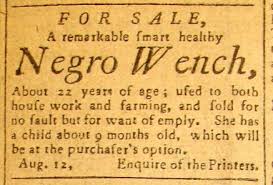At the Purchaser's Option
Lyrics and discussion questions for the song "At the Purchaser's Option" by Rhiannon GiddensRhiannon Giddens is a mixed-race African-American singer, banjoist, violinist, songwriter, music historian, and MacArthur genius grant recipient. This song was inspired by the slave advertisement pictured below.

“Last year I came across an advertisement from the 1830s for a young woman; thinking about her, and how she had to maintain her humanity against horrific odds inspired this song named for the end of the ad: ‘She has with her a 9-month old baby, who is at the purchaser’s option.”
I’ve got a babe, but shall I keep him?
‘Twill come the day when I’ll be weepin’
But how can I love him any less,
This little babe upon my breast?
You can take my body
You can take my bones
You can take my blood
But not my soul
I’ve got a body dark and strong
I was young but not for long
You took me to bed a little girl
Left me in a woman’s world
You can take my body
You can take my bones
You can take my blood
But not my soul
Day by day I work the line
Every minute overtime
Fingers nimble, fingers quick
My fingers bleed to make you rich
You can take my body
You can take my bones
You can take my blood
But not my soul
I’ve got a babe, but shall I keep him?
Questions for Discussion and Writing
1. To gain deeper insight into the song’s basic meaning, apply the SOAPSTone method of poetry analysis:
- What is the subject of the song?
- What occasion do you think the song is intended for?
- Who is the intended audience for the song?
- What do you think the purpose of the song is?
- Who is the speaker in the song?
- What is the tone of the song (the speaker’s attitude toward the subject)?
2. What message is the speaker expressing? In what sense can her soul not be taken (line 8)?
3. How does the situation described in the song reflect the advertisement that inspired it? What does the speaker mean when she asks, “Shall I keep him?” (line 1)? What emotional dilemma does her helplessness in this situation put her in, and what is her response to this dilemma?
4. In what sense was the speaker “young, but not for long” (line 10)? Discuss the meaning of the traumatic transformation described in the third stanza (lines 9-12) that was forced upon her. What possibility does this suggest about her child?
5. In what sense is “every minute overtime” (line 18)?
6. Identify and discuss the dehumanizing aspects of slavery depicted in the song. What stylistic and rhetorical strategies does the speaker use in expressing these truths?
Related Resources
Lyrics and Discussion Questions for “At the Purchaser’s Option” (PDF)
Live version of “At the Purchaser’s Option” (YouTube)
Rhiannon Giddens’ 21st-Century Sound Has a Long History (Smithsonian article)
Rhiannon Giddens Speaks for the Silenced (NPR interview and performance)
How Rhiannon Giddens Reconstructs Black Pain with the Banjo (NPR interview)